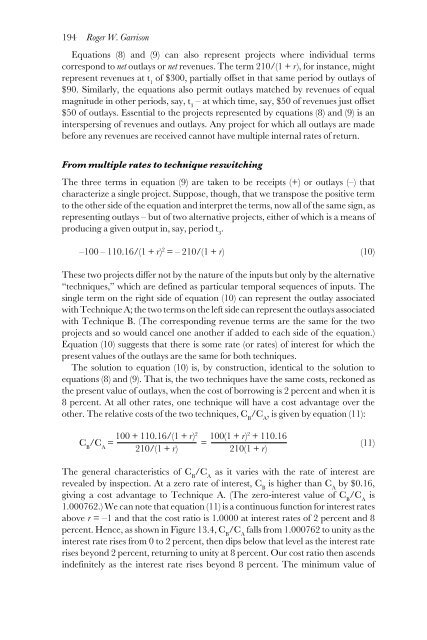Money and Markets: Essays in Honor of Leland B. Yeager
Money and Markets: Essays in Honor of Leland B. Yeager
Money and Markets: Essays in Honor of Leland B. Yeager
Create successful ePaper yourself
Turn your PDF publications into a flip-book with our unique Google optimized e-Paper software.
194 Roger W. GarrisonEquations (8) <strong>and</strong> (9) can also represent projects where <strong>in</strong>dividual termscorrespond to net outlays or net revenues. The term 210/(1 + r), for <strong>in</strong>stance, mightrepresent revenues at t 1<strong>of</strong> $300, partially <strong>of</strong>fset <strong>in</strong> that same period by outlays <strong>of</strong>$90. Similarly, the equations also permit outlays matched by revenues <strong>of</strong> equalmagnitude <strong>in</strong> other periods, say, t 3– at which time, say, $50 <strong>of</strong> revenues just <strong>of</strong>fset$50 <strong>of</strong> outlays. Essential to the projects represented by equations (8) <strong>and</strong> (9) is an<strong>in</strong>terspers<strong>in</strong>g <strong>of</strong> revenues <strong>and</strong> outlays. Any project for which all outlays are madebefore any revenues are received cannot have multiple <strong>in</strong>ternal rates <strong>of</strong> return.From multiple rates to technique reswitch<strong>in</strong>gThe three terms <strong>in</strong> equation (9) are taken to be receipts (+) or outlays (–) thatcharacterize a s<strong>in</strong>gle project. Suppose, though, that we transpose the positive termto the other side <strong>of</strong> the equation <strong>and</strong> <strong>in</strong>terpret the terms, now all <strong>of</strong> the same sign, asrepresent<strong>in</strong>g outlays – but <strong>of</strong> two alternative projects, either <strong>of</strong> which is a means <strong>of</strong>produc<strong>in</strong>g a given output <strong>in</strong>, say, period t 3.–100 – 110.16/(1 + r) 2 = – 210/(1 + r) (10)These two projects differ not by the nature <strong>of</strong> the <strong>in</strong>puts but only by the alternative“techniques,” which are def<strong>in</strong>ed as particular temporal sequences <strong>of</strong> <strong>in</strong>puts. Thes<strong>in</strong>gle term on the right side <strong>of</strong> equation (10) can represent the outlay associatedwith Technique A; the two terms on the left side can represent the outlays associatedwith Technique B. (The correspond<strong>in</strong>g revenue terms are the same for the twoprojects <strong>and</strong> so would cancel one another if added to each side <strong>of</strong> the equation.)Equation (10) suggests that there is some rate (or rates) <strong>of</strong> <strong>in</strong>terest for which thepresent values <strong>of</strong> the outlays are the same for both techniques.The solution to equation (10) is, by construction, identical to the solution toequations (8) <strong>and</strong> (9). That is, the two techniques have the same costs, reckoned asthe present value <strong>of</strong> outlays, when the cost <strong>of</strong> borrow<strong>in</strong>g is 2 percent <strong>and</strong> when it is8 percent. At all other rates, one technique will have a cost advantage over theother. The relative costs <strong>of</strong> the two techniques, C B/C A, is given by equation (11):100 + 110.16/(1 + r) 2 100(1 + r) 2 + 110.16C B/C A= = (11)210/(1 + r) 210(1 + r)The general characteristics <strong>of</strong> C B/C Aas it varies with the rate <strong>of</strong> <strong>in</strong>terest arerevealed by <strong>in</strong>spection. At a zero rate <strong>of</strong> <strong>in</strong>terest, C Bis higher than C Aby $0.16,giv<strong>in</strong>g a cost advantage to Technique A. (The zero-<strong>in</strong>terest value <strong>of</strong> C B/C Ais1.000762.) We can note that equation (11) is a cont<strong>in</strong>uous function for <strong>in</strong>terest ratesabove r = –1 <strong>and</strong> that the cost ratio is 1.0000 at <strong>in</strong>terest rates <strong>of</strong> 2 percent <strong>and</strong> 8percent. Hence, as shown <strong>in</strong> Figure 13.4, C B/C Afalls from 1.000762 to unity as the<strong>in</strong>terest rate rises from 0 to 2 percent, then dips below that level as the <strong>in</strong>terest raterises beyond 2 percent, return<strong>in</strong>g to unity at 8 percent. Our cost ratio then ascends<strong>in</strong>def<strong>in</strong>itely as the <strong>in</strong>terest rate rises beyond 8 percent. The m<strong>in</strong>imum value <strong>of</strong>
















